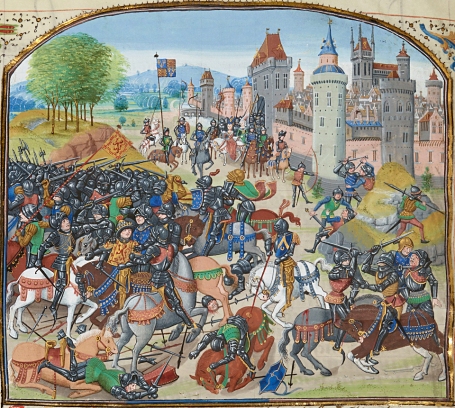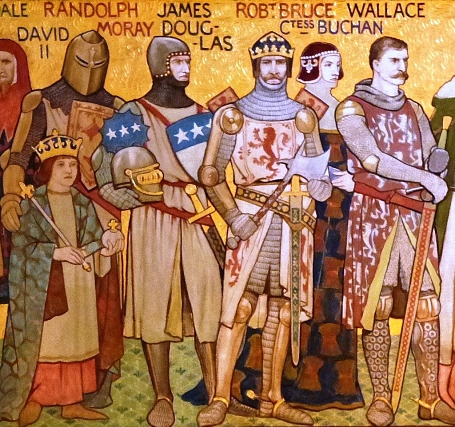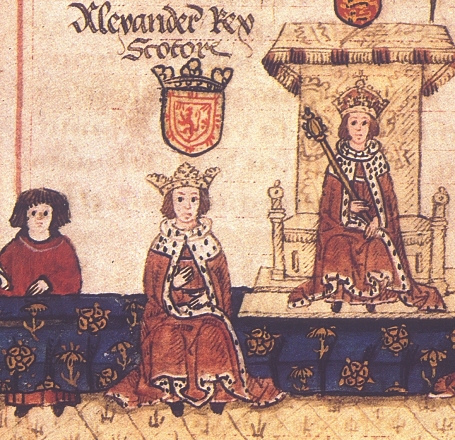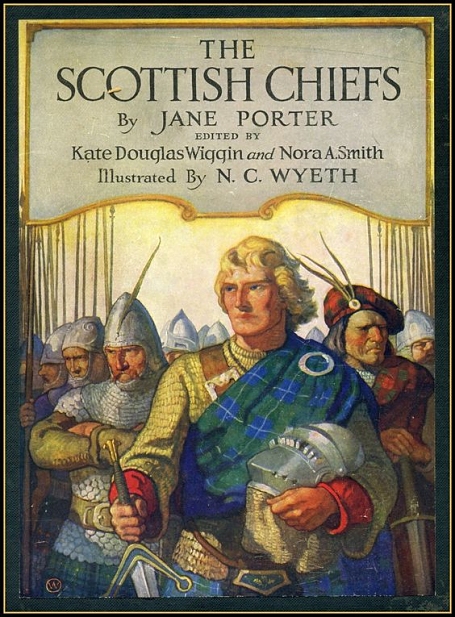The Life and Heroick Actions of the Renoun'd Sir William Wallace,
General and Governour of Scotland
by William Hamilton of Gilbertfield
Book III, Chapter III
How WALLACE slew the Buckler-player in the town of Ayr.
But Wallace Wight still tholing in his Breast
His Countrys Wrongs, at Crosbie could not rest,
Much did he grane in Travel for to be,
And sorely long'd the Town of Ayr to see.
So with Sir. Rannald passing on a Day,
Fifteen he took and to the Town went they.
Disguis'd they went, and in the Gate they saw
An English Fencer at the Weapon shaw.
There as he stood, his Buckler in his Hand,
Wallace near by a looker on did stand.
Lightly he said, "Scot darst thou 'sye a stroke?"
Quoth Wallace, "Yea, gan thou dar'st with me Yoke."
"Smite on," he said, "Thy Nation I defy."
Wallace therewith a fleg at him let fly;
The Sword so fell was on the Buckler cast,
Clear thro' his Harns it to his Shoulder past.
Lightly returning to his Men again,
The Women made a Din "Our Fencer's slain!."
The Man is dead; what need's of Words mair?
Fell Men of Arms then round him 'sembled there.
Eight Score at once upon Sixteen they set;
But Wallace quickly with the foremost met,
And lent him with good will a fearful Blow,
That thro' the Helmet shatter'd all his Pow.
Syne strake another so the Breast aboon,
The Sword went clear throughout th' unsonsy Loon,
Great Room he made, so did his trusty Men,
Till many a feckful Chiel that Day was slain.
For they were Wight, and well train'd up in Weir,
On English-Men right boldly did they bear.
Great Slaughter of the Enemies they made;
Their hardy Chief so well about him laid;
Till from the Castle new Recruits they spy'd.
Which Wallace seeing, wisely turn'd aside,
Thinking it safest to evite Surprise;
For he in War was not more Wight than Wise.
Then thro' the Throng as by main Force he past,
Their Harns and Heads asunder hew'd he fast.
Himself return'd the hindmost in the Rear,
Till he had brought his Men quite out of Fear.
Then to their Horse they went; thereafter rode
For better safety to the Laglan Wood.
Twenty and Nine they fell in that days Feed
Of South'ron Men that nevel'd were to Dead.
The Remnant to the Town did flee amain,
Cursing the Peace with Wallace they had tane,
Earl Piercy at the Heart was sorely griev'd
To find his Men thus wofully mischiev'd.
Three of his Kinsmen whom he held full dear,
Were slain that fatal Day in Armour clear.
Great moan he made, then to Sir Rannald sent
A Herald, charging him incontinent,
Wallace to keep from Market, Town and Fair,
(Skaith to prevent) where South'ron did repair.
The South'ron knew it Wallace was alone,
That them on this Mischance had overthrown,
And therefore kept the Truce made on their Word,
And liv'd with other Scots in good Accord.
Now Wallace on a Night from Laglane rade
To Crosbie, where the Knight his Uncle bade.
Upon the Morn, by it was peep of Day
Came in Sir Rannald where wight Wallace lay,
Shew'd him the Writ Earl Piercy to him sent,
And did entreat that he would give Consent
To do no Skaith to any English born,
Until the Truce were ended which was sworn.
Said Wallace, "Nought of Harm's be done by me,
That you may grieve, while I abide with thee."
His Uncle with him then accorded was,
And bad him welcome there his Time to pass.
There did he bide the Space of Seventeen Days,
Obey'd in ilky Thing that might him please.
But in his Mind remain'd another Thing;
Nor could he rest him tho' he were a King,
Till he his Friends, and native Land might see
From Thraldom, and proud English Lowns set free.
The ballad, The Life and Heroick Actions of the Renoun'd Sir William Wallace, General and Governour of Scotland, by William Hamilton of Gilbertfield, 1722, is in the public domain.

The Kingdom of England and the Kingdom of Scotland fought dozens of battles with each other. They fought typically over land, particularly Berwick-Upon-Tweed, and the Anglo-Scottish border frequently changed as a result. Read more at Wikipedia.

The First War of Scottish Independence was the initial chapter of engagements in a series of warring periods between English and Scottish forces lasting from the invasion by England in 1296 ... Read more at Wikipedia.

Edward I (1239-1307), also known as Edward Longshanks and the Hammer of the Scots, was King of England from 1272 to 1307. Read more at Wikipedia.

Digitized version of The Scottish Chiefs, by Jane Porter, a novelization published in 1921 by Charles Scribner's Sons, about William Wallace and the First Scottish War of Independence. Read online at archive.org.